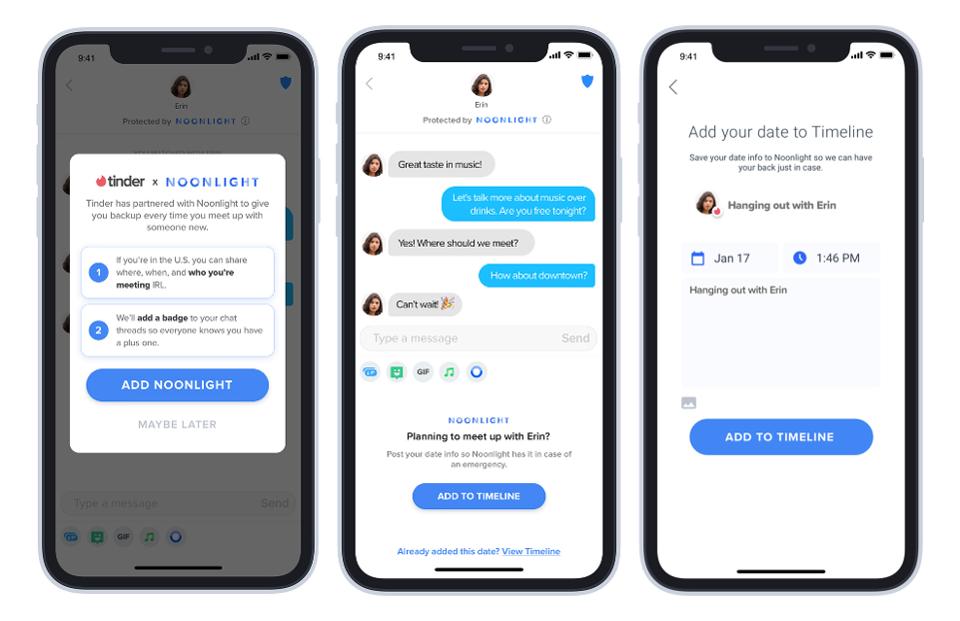Illustration of how Tinder’s new collaboration with Noonlight will appear on the Tinder app
TINDERSeveral new security features are being added to Tinder starting next Tuesday, January 28th. Match Group, an online dating giant that owns Tinder and other dating apps, announced that a panic button, photo verification, and an offensive messages feature will be incorporated into the popular online dating app and possibly the company’s other dating app holdings like OkCupid, Hinge, and Match.com in 2020.
In addition to dominating the online dating market, Match Group’s holdings are the apps that facilitate the majority of sexual assault cases involving online dating, including the grisly murder of British backpacker Grace Milane who was strangled by a man she met on Tinder, shoved into a suitcase, and then dumped in the woods. Critics attribute these instances to lax or nonexistent policies of verifying user identity and criminal background checks. Match Group suggests a solution can be found through its partnership with connected safety platform Noonlight, a company it has invested in, on its highest-grossing app, Tinder.
What are these new features?
Tinder will have a panic button, photo verification, and an offensive messages feature within the year. Its panic button will be delivered to users the fastest. It will appear in a new section of the app, called the Safety Center, next Tuesday. In the Safety Center, users can read dating safety tips as well as manually enter the date, time, and location of planned dates into a “Tinder Timeline” that can be shared with friends.
However, to access the Safety Center, users first need to download the Noonlight app and enable location tracking. Once that has been completed, they have the option to add a blue badge to their profile, a deterrent that Match Group’s CEO, Mandy Ginsberg, likens to a security system lawn sign and informs other users about Noonlight’s protection.
The actual panic button is in the separate Noonlight app, not the Tinder app.
In a dangerous situation, pressing and holding the panic button discreetly contacts Noonlight dispatchers who send a text with a code and then call. If the call is unanswered, the dispatchers immediately alert emergency services.
Tinder’s photo verification hopes to cut down on the necessity of the panic button by screening the app for catfish. Users receive a blue verification mark on their profiles by taking photos that match a series of sample poses. Tinder’s community team then reviews the consistency between the submitted photos and photos previously uploaded to the app.
Tinder’s Photo Verification Feature
TINDERLastly, Tinder’s offensive message feature, “Does This Bother You?”, makes it easier for users to report offensive messages. AI detects potentially inappropriate messages and asks if the user is “bothered” by its content. If the answer is yes, they can report their match. Improved machine learning may also enable an “Undo” feature on Tinder where senders are warned that their message is potentially offensive, similar to Instagram’s 2019 “Are You Sure You Want To Post This?”
Unlike the panic button, photo verification and the offensive message feature are being rolled out slowly and currently being tested in smaller areas before being available for everyone.
Will any of this work?
When it comes to these security updates, Match Group has the advantage of analyzing how they have been received on other apps. Tinder is trailing in terms of user safety. U.S. Uber users have had access to a panic button since 2018. Bumble started using photo verification in 2016, and Instagram made anti-bullying the cause of its crusade in 2019. Adopting the policies of its app store peers will likely make Tinder a safer place. Nonetheless, the rollout of these updates and their failure to tackle certain areas make them less effective than ideal.
Notably, Tinder’s new features make no mention of screening users for criminal history, specifically sex crimes. Just last month, a collaborative report between, Buzzfeed, Columbia Journalism Investigations, and ProPublica chastised Match Group for not cross-referencing its list of users with state sex offender lists except for Match.com paid subscribers, allowing Tinder, Hinge, and OkCupid users to unknowingly match with known sex offenders. Tinder’s update does nothing to diminish this possibility.
If Tinder users do find themselves on a date with a sex offender or in another dangerous situation, the panic button’s design may pose some problems. It’s not in-app, which Tinder justifies by arguing that the feature’s purpose is to give users a way to ask for help without raising suspicion. Yet, opening Noonlight, a known safety app, on a Tinder date in place of the Tinder app doesn’t appear to be any less suspicious. The additional downside to requiring a separate app for the panic button is that users don’t have automatic access to it. With cellphone storage limits, a Tinder user who accidentally deleted Noonlight to download Netflix before their date could become a victim.
The Safety Center includes quizzes, resource lists, and tips.
TINDERWhat about my data?
Digital privacy advocates view location tracking warily, and Tinder’s Noonlight announcement is no different. Although users can allow Noonlight to track them only when using the app, Tinder acknowledged that there is some tradeoff between privacy and safety in this new picture. In a Wall Street Journal article, Ginsberg states that location data would not be used for marketing. However, recent findings from Gizmodo show this data is sent to third-parties such as Facebook, YouTube, Braze, Appboy, and Kochava, challenging the idea that location data is exclusively kept between the user, Noonlight, and emergency services.
Tinder’s coming safety features are poised to help users in a world of online dating that is not completely danger-free. They align Tinder with its app store peers in accomplishing a minimum for user safety. Yet, where Tinder diverges from the rest, specifically in its relationship with Noonlight, necessitates that singles looking for love understand how to navigate the tools designed to protect them.

